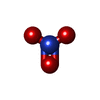+Search query
-Structure paper
| Title | Simultaneous binding of Guidance Cues NET1 and RGM blocks extracellular NEO1 signaling. |
|---|---|
| Journal, issue, pages | Cell, Vol. 184, Issue 8, Page 2103-2120.e31, Year 2021 |
| Publish date | Apr 15, 2021 |
 Authors Authors | Ross A Robinson / Samuel C Griffiths / Lieke L van de Haar / Tomas Malinauskas / Eljo Y van Battum / Pavol Zelina / Rebekka A Schwab / Dimple Karia / Lina Malinauskaite / Sara Brignani / Marleen H van den Munkhof / Özge Düdükcü / Anna A De Ruiter / Dianne M A Van den Heuvel / Benjamin Bishop / Jonathan Elegheert / A Radu Aricescu / R Jeroen Pasterkamp / Christian Siebold /   |
| PubMed Abstract | During cell migration or differentiation, cell surface receptors are simultaneously exposed to different ligands. However, it is often unclear how these extracellular signals are integrated. Neogenin ...During cell migration or differentiation, cell surface receptors are simultaneously exposed to different ligands. However, it is often unclear how these extracellular signals are integrated. Neogenin (NEO1) acts as an attractive guidance receptor when the Netrin-1 (NET1) ligand binds, but it mediates repulsion via repulsive guidance molecule (RGM) ligands. Here, we show that signal integration occurs through the formation of a ternary NEO1-NET1-RGM complex, which triggers reciprocal silencing of downstream signaling. Our NEO1-NET1-RGM structures reveal a "trimer-of-trimers" super-assembly, which exists in the cell membrane. Super-assembly formation results in inhibition of RGMA-NEO1-mediated growth cone collapse and RGMA- or NET1-NEO1-mediated neuron migration, by preventing formation of signaling-compatible RGM-NEO1 complexes and NET1-induced NEO1 ectodomain clustering. These results illustrate how simultaneous binding of ligands with opposing functions, to a single receptor, does not lead to competition for binding, but to formation of a super-complex that diminishes their functional outputs. |
 External links External links |  Cell / Cell /  PubMed:33740419 / PubMed:33740419 /  PubMed Central PubMed Central |
| Methods | EM (single particle) / X-ray diffraction |
| Resolution | 3.15 - 5.98 Å |
| Structure data | EMDB-12286, PDB-7ndg:  PDB-7ne0:  PDB-7ne1: |
| Chemicals |  ChemComp-CA:  ChemComp-NAG:  ChemComp-SO4:  ChemComp-NO3: |
| Source |
|
 Keywords Keywords |  SIGNALING PROTEIN / SIGNALING PROTEIN /  Signal transduction / cell surface receptors / neuron regeneration / Signal transduction / cell surface receptors / neuron regeneration /  cell migration / cell migration /  Netrin / Netrin /  Neogenin / Neogenin /  Repulsive Guidance Molecule / complex structure / Repulsive Guidance Molecule / complex structure /  protein-protein interactions / cell surface receptor signaling / protein-protein interactions / cell surface receptor signaling /  axon guidance / migration / axon guidance / migration /  cancer / cancer /  growth cone / receptor clustering growth cone / receptor clustering |
 Movie
Movie Controller
Controller Structure viewers
Structure viewers About Yorodumi Papers
About Yorodumi Papers







